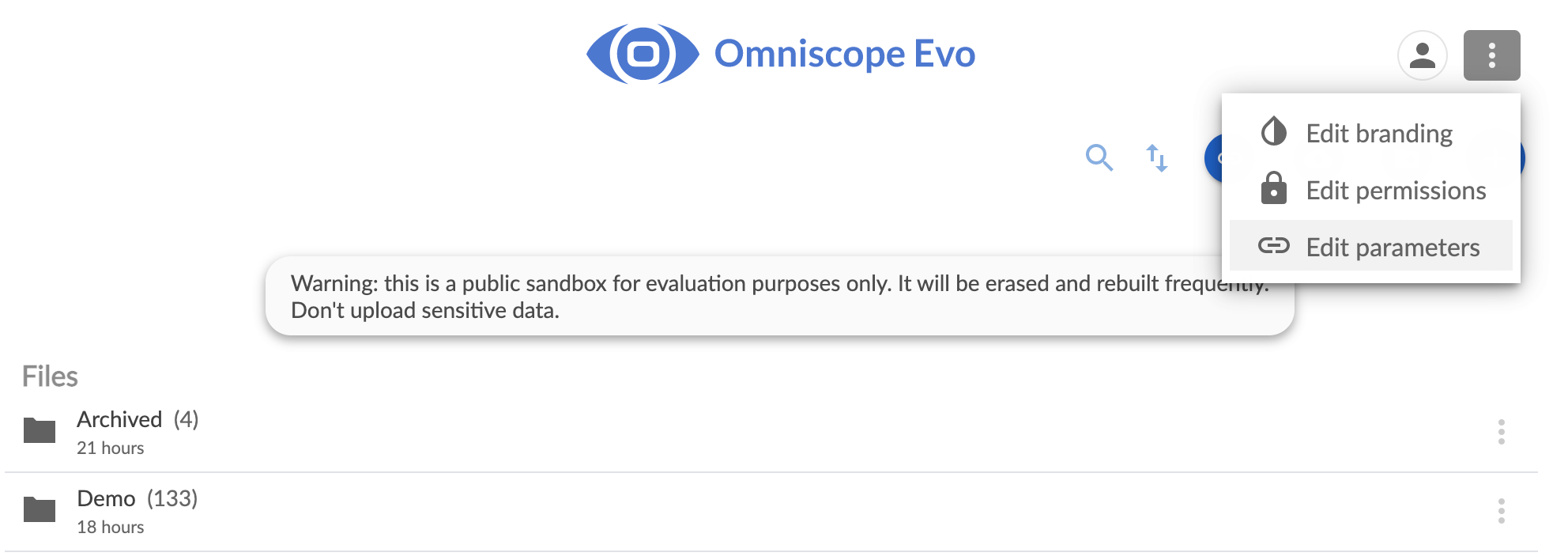Omniscope Evo offers multiple effective methods to control your workflow executions.
Parameters application makes the workflow very easy to manage and control centrally in situations where repetitive executions differ in a single parameter value.
A parameter is a simple key/value pairing. A key is a unique name that refers to the parameter itself, and a value can be a boolean, number, date or text. The key is then used as a reference within the Block options.

Here are some scenarios where parameters could be effectively used in the report publishing process:
- Parameters allow you to "bookmark" important pieces of information, which you can manage and update centrally (i.e. database connection details), then use in one or multiple projects
Example:
You can use parameters to store your database connection credentials like username/password, host etc, and then use them inside your database blocks in any project. When you update a parameter value at a later date - all your projects will be automatically updated to refer to the new value. - Parameters allow you to to organise multiple workflow executions from the Scheduler application, by remotely switching the parameter value, then executing the workflow and publishing the report variations. You can create a parameter which is used in the Record filter block rules. The parameter value can be controlled/updated from the Scheduler's edit parameters action. At the next execution the parameter will automatically pick a new value, without the need to manually open the workflow and re-configure the Record filter block options.
Example:
This is the best approach when publishing multiple variations of the same report: report for a 'Client A' could be generated, then the Scheduler would execute the workflow for 'Client B' and so on, until the cycle through the list of param values is completed.
NOTE: The parameter values are utilised at the point of workflow execution. If you updated the parameter value, you would need to execute the workflow, in order for the new value to be applied to the block options and harvest the new data.
How to create parameters
There are two methods to create parameters in Omniscope Evo.
1. Application-wide
Application-wide parameters are available to all projects on the server. These can be created from Files > 3 dots > Edit parameters:


2. Project level
Project parameters are only available within the project they were created in. You can create these parameters from within the
Workflow app > Three dots (top right) > Parameters

Note: If you create Project parameters with the same name as the application-wide params, then the Project parameters take precedence.
How to refer to parameters within a Block
Once you have created your parameters you can then refer to them within multiple block options. When you open the block options and you see a small "Link icon", this is an option where you to choose an appropriate parameter.
Note: Parameters are type-specific, so you will not be able to choose a text parameter for an option that only accepts number values.

After you have linked an option to a parameter you should see a purple link icon with option becoming disabled.

In the above example, the password field will now take the value of the "My text param" every time the workflow is executed.
As mentioned above, once you link an option to a parameter, and you then change the value, you will need to re-execute the block in order for the new parameter setting to produce data.
Template based parameters
From 2021.2, you can now use parameters embedded within text options such as URLs for the File block, by choosing Templated within the parameter link menu:

You will see some example text, and will be able to edit the option value, changing the parameter name and placement, and inserting additional parameters enclosed in {{ and }} text:

This is useful when you wish to build up, for example, a web address with parameters driving parts of the URL such as the folder path or query parameters.
Managing parameters via Scheduler
You can use the Scheduler application to centrally update parameters defined in the workflow.
Editing app-wide parameters
Add a new Task and choose "Edit app-wide parameters" .

Editing Project parameters
To edit a particular Project parameters remotely, you need to first add "Project action", then choose "Edit project parameters" as the file action.

Once you have updated the parameters, you should "Add execute block action" to make your project take note and execute the workflow with the new values.
Attached is a "Parameters" demo, which shows how you could use the "Project parameters" to control a workflow. Simply upload the IOZ file to your server to examine the configuration.
You can see another example here, on our sandbox (no need to download anything).

Was this article helpful?
That’s Great!
Thank you for your feedback
Sorry! We couldn't be helpful
Thank you for your feedback
Feedback sent
We appreciate your effort and will try to fix the article